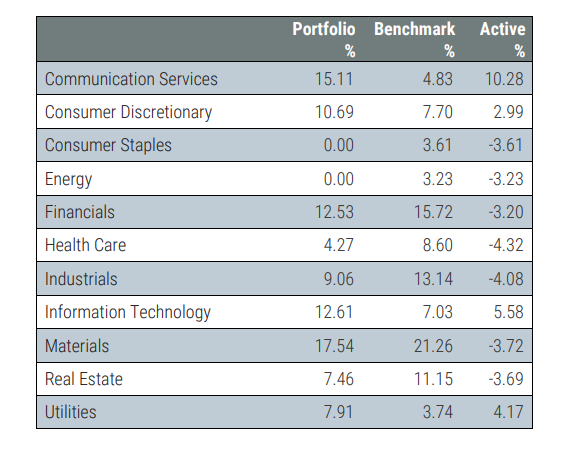This portfolio manager looks outside the ASX 20 for opportunities. Here are 6 of his favourites
62% of the value of ASX sits in the top 20 stocks, making it easy to overlook the concentration risk. But for Edward Waller, deputy portfolio manager of the Yarra Ex-20 Australia Equities Fund, this creates an opportunity to look for opportunities in those ASX200 companies that sit outside the top 20 instead.
I caught up with Waller earlier this week to discuss the portfolio, the sector weights in the portfolio and his two highest-conviction stocks. As you will see below, he gives us four other stocks he is excited about - two relating to the energy transition and two relating to the growing technology sector.

Note: this interview with Ed Waller took place on Monday 9 October 2023. Yarra Ex-20 Australian Equities Fund has positions in the stocks mentioned in this wire.

The case for ex-20
LW: What are the advantages of using an ex-20 fund over alternatives such as small-caps and micro-caps?
Waller: We consider ex-20 both against small and mid-caps, but as an alternative to ASX 200 products as well. Stripping it back, 62% of the ASX 200 is dominated by the top 20 stocks. By moving outside those top 20 stocks, you see a far lower concentration to financials because you're excluding the big banks. You also have a lower concentration on metals and mining because you're excluding the large iron ore producers.
When compared to some of the small and mid-cap indices, investing in the ex-20, provides that mid-cap exposure but within a much deeper market. You've got two times the market cap of either of those indices and, obviously, much higher levels of liquidity as well.
Investing in mid-caps offers outperformance
LW: You believe investing in the mid-cap space will generate outperformance. What evidence do you have to support this belief?
Waller: If you look at the ex-20 benchmark compared to mid and small caps, it's been a strong and consistent performer over pretty much every time series, including the most recent 1, 3, 5 and 10 year periods. Ex-20’s strong performance has, critically, has also come with lower levels of volatility (refer to the table below).
|
10 Year |
Capital |
Dividend |
Mkt Cap |
Volatility |
ASX 300 |
9.1 |
5.6 |
3.5 |
854 |
15.1 |
ASX 200 |
9.5 |
6.1 |
3.4 |
444 |
16.0 |
Smalls |
5.7 |
2.7 |
3.1 |
347 |
16.9 |
Source: S&P and Factset. Data as at 31 August 2023
However, that's very much a backward-looking perspective. When we think about the opportunity for outperformance going forward and compare it to the ASX 200, which is dominated by those top 20 stocks, we see that the majority of the top 20 relates to either banks, iron ore miners, or fossil fuel producers. And while those sectors have been really strong drivers of market returns over the last 20 years, as we look forward to the next decade, we don't believe they'll be nearly as prominent as drivers of market returns. By way of contrast, those same sectors only represent 5% of the ex-20 index.
We categorise the ex-20 index as being far more about Australia's future than its past. Some of the sectors which are more heavily represented in ex-20 include sectors such as technology, battery materials and new media. Combined, these sectors represent a meaningful proportion of the ex-20 index and frequently offer up much higher revenue growth stocks. To illustrate the point, there is only one stock in the ASX 20 that is expected to achieve over 10% revenue growth in 2024, whereas there are 56 stocks in the ex-20 with that level of forecast growth.
Overweight sectors
LW: Looking at your portfolio as outlined in the August 2023 monthly note, you’re overweight in only four of the 12 sectors relative to your benchmark. What does that say about your view of markets right now?

Waller: Our process is driven by bottom-up stock picking, and as a result, sector weights tend to fall out from our stock selection process. We do keep an eye on the sector risks and overweight positions. We try to limit both stock and sector risk to less than 20% of total portfolio risk. At the moment, they’re both sitting much lower than that.
As an example of how this plays into our view on markets right now, one observation from the August reporting season was the quite volatile stock price reactions to corporate earnings updates, with even small misses to consensus expectations resulting in large share price declines. This volatile start to FY24 – which has also persisted into the start of October – is bringing more opportunities for active investors with a more long term approach.
While for a lot of investors that volatility can naturally cause a bit of anxiety. As bottom-up stock pickers we welcome that environment, since it typically throws out some attractive long-term investment opportunities. That's what we're focused on right now.
Utilities: no longer a boring sector
LW: You’re significantly overweight in utilities, what might be described as one of the more boring parts of the market. What do stocks in this sector bring to the portfolio?
Waller: The reality in the utilities sector now is it's really only three stocks, AGL (ASX: AGL), Origin Energy (ASX: ORG) and APA (ASX: APA).
Over the last five years, we've seen all the listed regulated utilities become privatised. So it's probably a little less boring than it was in the past, given that all three of those stocks in one way or another are going to be significant players in Australia's energy transition. As a result, we have overweight positions in Origin Energy (also on the block to be privatised) and APA.
We've had a long-term investment in Origin Energy and that's really been based on its strong structural position for the energy transition.
APA was introduced into the portfolio more recently, and we participated in their August capital raising. Although the company’s share price has fallen this calendar year, what's changed is the challenges we're seeing in the speed at which new renewable developments are coming to market. These challenges suggest that the renewable energy transition may take longer than the market has been anticipating.
As a result of this likely delay, there is now greater visibility on how long gas will remain in Australia’s energy system and that will positively impact the strength of APA’s cash flows over time. While we see continued strong cash flows from their traditional business, they’ve got some reasonably attractive entry points into the energy transition, particularly in electricity transmission across the East Coast. APA’s recent acquisition of Alinta Energy’s Pilbara assets has also expanded their renewable generation asset and development portfolio.
Technology stocks continue to show promise
LW: You’re also significantly overweight in technology stocks, a volatile sector of the market. What is the thesis here? Why do you believe that tech can outperform in the future?
Waller: The portfolio is overweight technology and that's really driven by two main positions in NextDC (ASX: NXT) and Xero (ASX: XRO).
It's important to step back and note that we aim to maintain style-neutral portfolios. So, while NextDC and Xero are obviously growth businesses, we're balancing that out through portfolio construction to ensure we maintain a relatively style-neutral approach.
NextDC has increased their contracted utilisation by more than 75% year to date. That’s impressive growth on any measure, and really highlights the continuing demand for data centre services. With the advent of Artificial Intelligence (AI) and the uptake of AI-led solutions – both of which require greater computing power – that demand remains particularly strong.
Xero is an interesting one. It's a business we’ve always liked, but in recent years we haven't owned it because we couldn't make sense of the valuation. We initiated a position in mid-last year after the stock had halved, and since then we've seen Xero implement a couple of levers that have significantly improved visibility into its long-term growth trajectory. Xero is showing a greater willingness to use pricing as a lever to drive revenue growth, and they're also implementing more discipline in the business in managing costs which provides greater confidence around the future earnings profile.
Highest conviction holdings
LW: You’ve already given us your thesis for five of the stocks in your portfolio. Can you provide a short thesis for one of your highest conviction holdings in the portfolio?
Waller: The portfolio has a large position in Insurance Australia Group (ASX: IAG). The domestic insurance sector has faced several headwinds over the last few years, including large natural disasters, claims inflation and rising reinsurance costs. But IAG has demonstrated a degree of resilience in the face of these challenges. They have effectively managed to offset these input cost pressures by passing them on through price increases to consumers. This positions them relatively well going forward.
The last three years have been dominated by La Niña, bringing cooler than average sea temperatures and extreme rainfall events. As we move into another El Niño weather pattern – the opposite of what we’ve experienced through La Niña – that lowers the probability of extreme weather events. We can’t say they won’t happen, but it does lower the probability and we should see the earnings power of that business come through. It’s currently trading on less than 15 times forward earnings, which we regard as a reasonably undemanding multiple. We view IAG very much as a core holding in the portfolio.
5 topics
6 stocks mentioned
1 fund mentioned
1 contributor mentioned